
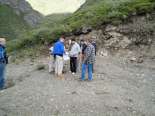
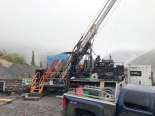
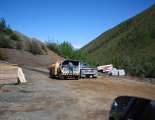
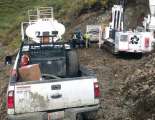
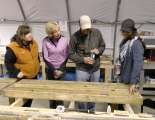

Vancouver, B.C., July 17, 2013: Prophecy Platinum Corp. (“Prophecy Platinum” or the “Company”) (TSX-V: NKL; OTC-QX: PNIKF) is pleased to announce the commencement of the 2013 field program at its 100%-owned Wellgreen PGM-Nickel-Copper project in Canada’s Yukon Territory. Field activities, metallurgical test work and engineering initiatives commenced in June with the comprehensive re-logging and re-sampling of up to 12,000 metres of historic drill hole cores from across the main Wellgreen deposit, approximately 75% of which have never been tested. A targeted exploration drilling program, designed to facilitate a higher-grade, lower CAPEX start-up concept convert a significant amount of Inferred Mineral Resources to the Measured and Indicated category, and test recently determined potential high-grade zones, is set to begin before the end of July.
Our 2013 Wellgreen exploration program has been designed to support and maximize the results of a revised Preliminary Economic Assessment (PEA) and updated mineral resource estimate as the next major milestones in the development of the project. The updated PEA, expected to be completed in the first half of 2014, will reflect a new approach to the project under which a significantly reduced CAPEX and enhanced economic Key Performance Indicators are key goals. In addition to the field activities now underway, environmental, socio-economic, engineering and metallurgical contracts have been awarded in accordance with the Company’s target timeline.
Outline of the 2013 Exploration Program:
Greg Johnson, President and CEO, states, “With our $5.9-million financing completed, we have the working capital to carry out the next phase of work at our Wellgreen project. During the past six months, our technical team has undertaken a comprehensive review of the project, including a compilation of all historic information on the deposit back to the 1950s. We are excited about key new observations on the controls to the disseminated PGM, nickel and copper mineralization that have come out of new geologic modelling work. Wellgreen shares many geologic characteristics with such world-class PGM deposits as Norilsk and Voisey’s Bay. However, the width of continuous significant PGM mineralization starting at surface, which includes zones up to 500 metres in thickness, makes Wellgreen unique among these other major PGM systems. In addition, several of these broad, higher-grade zones have been identified that have the potential to be optimized early in the mining of the project and that should further improve the already positive existing economics described in the 2012 PEA.”
Mr Johnson continues, “Concurrent with the work on targeting new higher-grade bulk mineable zones, a metallurgical program is underway to optimize metal recoveries, particularly in the PGMs. Engineering studies are also investigating a number of opportunities to lower operating and capital costs to further boost project returns. As part of an updated PEA planned for the first half of 2014, management is targeting an initial start-up capital expenditure in the range of $300 to $400 million with phased expansion to the ultimate project capacity to occur over time. We believe this flexible approach to the project will allow development to accelerate, while also demonstrating the project’s larger-scale potential production levels. Wellgreen is one of the largest PGM resources outside of southern Africa and Russia and, with the sector confronting protracted global supply issues, we are looking at a number of opportunities to expedite this important project’s path to production.”
Wellgreen 2013 Field and Engineering Activities
The grade thickness plan view below shows the grade-thickness results for the drilling to date on the Wellgreen project and indicates that, although the deposit remains open, the currently defined system is at least 2.5 kilometres long and 1.5 kilometres wide. Please refer to the Company’s news release dated February 4, 2013 for details on our most recent drill results.
“Wellgreen Project Preliminary Economic Assessment, Yukon, Canada” dated effective August 1, 2012 (the “2012 PEA”) prepared by Andrew Carter, P.Eng., Pacifico Corpuz, P.Geo.,Philip Bridson, P.Eng. and Todd McCracken, P.Geo., is as a bulk mineable system which would principally use open pit mining, potentially supplemented with large-scale underground methods. Mineralization is hosted in a tabular ultramafic body that begins at surface to at least 700 metres depth with typical widths of 75-100 metres with zones up to 300-500 metres of continuous mineralization.
Mineralization generally grades 1.5-4.5 g/t platinum equivalent (Pt Eq.) with typical grade thickness (grade x width) values of 100 - 300 gram-metres Pt Eq. and the occurrence of zones exceeding 1,000 gram-metres Pt Eq. The open pit cut-off grade is anticipated to be 0.70 g/t Pt Eq., while a bulk underground cut-off grade would be anticipated to be approximately 1.5 g/t Pt Eq.
Re-Sampling Program
The first phase of this season’s field work at Wellgreen started with a re-sampling program on up to 12,000 metres of historic drill core that was previously only selectively sampled for very high grade, massive sulphide material. 75% of the drill hole core from the potentially bulk mineable ultramafic hosted mineralization was never sampled. These historic holes are now being analyzed from this bulk mineability perspective across broad zones of disseminated mineralization for platinum, palladium, rhodium, and gold (4E) in addition to nickel, copper, cobalt and trace elements. The analysis will include NI 43-101 quality control processes to allow these historic drill holes to be utilized in the next mineral resource update and revised PEA.
This re-sampling program highlights the contrast between the historic model which focused on narrow, very high-grade zones in the deposit and the current approach which looks at potential open pit and bulk mineable underground production. This low-cost, high-impact re-sampling program will allow for better assessment of bulk mineability across a large area of the deposit and has the potential to define new zones of mineralization that have not been previously recognized (see figure below). Samples from the East and Far East Zones (E and FE) and North Arm have been submitted for analysis with broad visually mineralized intervals of ultramafic intrusive rocks. First results from this re-sampling program should be available within the next 4 to 6 weeks.
Drill Program
Our 2013 drill program will be conducted by Boart Longyear Canada Inc. and, as noted above, has the following key objectives:
Two areas, the Far West Zone (FW) and the Far East Zone, demonstrate wide intervals of mineralization that are of significantly higher grade than the average of the deposit. These will be assessed in order to determine whether they can potentially be accessible and scheduled within the first 5-10 years of operation.
The Far West target, which begins at surface, is significantly enriched in PGMs and is as much as three times higher than the average grade. The Far West Zone is at the western end of the deposit and is open to expansion down dip. In addition, geophysical surveys in the Far West indicate the potential for an untested parallel zone. The Far West and West (W) areas both contain higher grade material which will be further investigated to determine potential suitability for location of possible starter pits.
A second higher grade target area occurs within the Far East Zone at the eastern end of the main Wellgreen deposit. Modeling and compilation of historic drill holes has identified a thick mineralized zone which appears to occur in this area to the north of the main tabular Wellgreen deposit. This zone is completely open to the east and may connect the main Wellgreen deposit with the nearly untested North Arm ultramafic body. The North Arm falls within the current pit model but, due to a lack of modern drilling data, is not included in the current mineral resource estimate. This area has the potential of being reclassified from waste material into a mineral resource designation, adding to the economics of the Wellgreen project. The areas to the east and north of the main deposit hold potential for expansion of the mineral resource, with some of the best holes drilled in the deposit to date in these areas.
In addition to the two areas highlighted above, the main Wellgreen deposit appears to be open to expansion over its entire 2.5 kilometre length down dip to the south. Key drill holes are planned to offset higher grade mineralized zones and bring these areas, which are currently within the pit model as unclassified blocks, into the mineral resource. The Central Zone (C) is one of these areas for testing down dip, where two of the best grade-thickness holes in the deposit (WS-188 and WS-214) have not yet been offset.
The development of new geologic model has enabled the technical team to map out a targeted offset and infill drilling program designed to maximize conversion of existing Inferred resources into the Measured and Indicated category and thereby increase overall confidence in the mineral resource.
Lastly, a series of high-priority, road accessible targets adjacent to the main Wellgreen deposit are viewed by the Company as having potential for the discovery of new higher grade, near surface mineralization. These targets, which include the Quill and Burwash areas, are outside of the current limits of the current mineral resource model but demonstrate geomagnetic and surface geochemical signatures which are strikingly similar to those found at Wellgreen proper. Initial results indicate the possibility that these sites may be part of the same overall system which exceeds 18 kilometres in length.
Metallurgical Optimization
The metallurgical program will be conducted by Eggert Engineering, who is being assisted by Mike Ounpuu, Consulting Metallurgist.
Metallurgical test work has commenced at SGS Minerals Services at Lakefield. This program is pursuing optimization opportunities including improved 3E PGM and base metals recovery and recovery of rare PGMs as well as increased concentrate grades. The test work, upon which assumptions in the 2012 PEA were based, was preliminary in nature and attained the initial objective of demonstrating that the disseminated mineralization would report to a conventional sulfide flotation circuit and would also report to separate nickel and copper concentrates.
The 2013 metallurgical program will test optimization of the flotation recovery of the metals by using variation of grind size, flotation methods, magnetic separation methods and other techniques to enhance overall recovery of PGMs and base metals and improve overall concentrate value.
During its production phase in the early 1970s, Wellgreen operated as an underground mine focused on very high-grade horizons and produced a bulk concentrate which was purchased by Sumitomo in Japan containing PGMs, nickel and copper along with rare PGM’s including rhodium, osmium and iridium.
Engineering and Mine Plan Optimization
Studies currently underway are examining a staged development approach with a smaller scale start-up operation, including reduced initial CAPEX and improved economic key performance indicators.
The Company has awarded the surface infrastructure engineering contract to JDS Energy & Mining Inc. (JDS). and the tailings pond engineering will be conducted by Knight Piesold. In addition, the Company is currently assessing contractors in relation to the open pit and underground mine engineering work.
The revised PEA will include Liquefied Natural Gas (LNG) as a primary power source, which will significantly decrease the $0.28 per kW/h unit operating cost cited in the 2012 PEA, as well as optimize the location and general arrangements of the mill, tailings storage facility and other site facilities.
In addition, the project team has commenced with a benchmarking analysis that establishes comparisons regarding pre-production CAPEX, production throughput, mineral processing requirements and metallurgical performance at similar projects.
John Sagman, Senior Vice President and Chief Operating Officer, indicated, “Prophecy Platinum has recruited additional personnel and engineering firms with the necessary expertise and experience to effectively contribute to the updated PEA that is expected to further define Wellgreen as a project with robust economics and one that is well supported by First Nations and stakeholders. Following completion of an updated PEA early in 2014, the Company expects to initiate Pre-feasibility level studies in 2014, and Feasibility level studies in 2015.”
Shakespeare Project Activities
Concurrent with the advancements on the Wellgreen project, during 2013, Prophecy Platinum has been conducting a comprehensive review of its fully-permitted, production ready Shakespeare PGM-Nickel- Copper mine located in the Sudbury mining district of Ontario. This review has been focused on opportunities to reduce operating costs in three key areas: toll milling/smelting costs, reduction in ore haulage transport costs using a new route proposed by the Sagamok Anishnawbek First Nations, and refinement of the mine plan/site operations. At sustained recent metal prices Shakespeare could provide a source of funding for the exploration and engineering activities at Wellgreen as well as provide benefits to the Sagamok Anishnawbek First Nations and local community stakeholders.
We anticipate issuing regular news updates over the coming months as we undertake re-sampling and exploration programs, complete metallurgical optimization studies, and engineering updates.
About Prophecy Platinum
Prophecy Platinum Corp. is a growth-focused PGM exploration company with projects in the Yukon Territory, Ontario and Manitoba, Canada. The Company’s 100% owned Wellgreen PGM-Ni-Cu project, located in the Yukon, is one of the world’s largest undeveloped PGM deposits and one of few significant PGM deposits outside of southern Africa or Russia. The Company’s Shakespeare PGM-Ni-Cu project is a fully-permitted, production-ready mine located in the Sudbury mining district of Ontario, and its Lynn Lake project is a former operating mine located in Manitoba, Canada. The Company’s experienced senior management team has a track record of successful, large-scale project discovery, development, operations and financing combined with an entrepreneurial approach to sustainability and collaboration with First Nations and communities. The Company’s shares are listed on the TSX Venture Exchange under the symbol “NKL” and on the US OTC-QX market under the symbol “PNIKF”.
Further information about the Company and its projects can be found at www.prophecyplatinum.com.
Prophecy Platinum Contacts:
Greg Johnson Chris Ackerman | 1-800-459-5583 |
Quality Assurance: The technical information in this news release has been prepared in accordance with Canadian regulatory requirements set out in National Instrument 43-101 Standards of Disclosure for Mineral Projects of the Canadian Securities Administrators (“NI 43-101″). The Wellgreen Project geological technical information is supervised and reviewed by Neil Froc, P. Eng., Prophecy Platinum Wellgreen Project Manager, a “Qualified Person” as defined in NI 43-101 and the person who oversees exploration activities on the Wellgreen Project. All other technical information is supervised and reviewed by John Sagman, P.Eng., Prophecy Platinum’s Senior Vice President and Chief Operating Officer and a “Qualified Person” as defined in NI 43-101. In addition, Mr. Sagman has reviewed and approved the geological technical information contained in this news release.
Forward Looking Information:This news release includes certain information that may be deemed “forward-looking information”. All information in this release, other than information of historical facts, including, without limitation, information regarding the 2013 filed program with respect to resampling, drilling, metallurgical optimization, engineering and mine planning, the timing and success of exploration activities generally, the timing of future technical reports and general future plans and objectives for the Wellgreen and Shakespeare projects are forward- looking information that involve various risks and uncertainties. Although the Company believes that the expectations expressed in such forward-looking information are based on reasonable assumptions, such expectations are not guarantees of future performance and actual results or developments may differ materially from those in the forward- looking information. Forward-looking information is based on a number of material factors and assumptions. Factors that could cause actual results to differ materially from the forward-looking information include unsuccessful exploration results, changes in project parameters as plans continue to be refined, results of future resource estimates, future metal prices, availability of capital and financing on acceptable terms, general economic, market or business conditions, risks associated with operating in foreign jurisdictions, uninsured risks, regulatory changes, defects in title, availability of personnel, materials and equipment on a timely basis, accidents or equipment breakdowns, delays in receiving government approvals, the Company’s ability to maintain the support of stakeholders necessary to develop the Wellgreen project, unanticipated environmental impacts on operations and costs to remedy same, and other exploration or other risks detailed herein and from time to time in the filings made by the Company with securities regulatory authorities in Canada. Readers are cautioned that mineral resources that are not mineral reserves do not have demonstrated economic viability. Mineral exploration and development of mines is an inherently risky business. Accordingly, actual events may differ materially from those projected in the forward-looking information. For more information on the Company and the risks and challenges of our business, investors should review our annual filings which are available at www.sedar.com. The Company does not undertake to update any forward looking information, except in accordance with applicable securities laws.
Cautionary Note to United States Investors: This news release has been prepared in accordance with the requirements of the securities laws in effect in Canada, which differ from the requirements of U.S. securities laws. Unless otherwise indicated, all resource and reserve estimates included in this news release have been prepared in accordance with NI 43-101 and the Canadian Institute of Mining, Metallurgy, and Petroleum Definition Standards on Mineral Resources and Mineral Reserves. NI 43-101 is a rule developed by the Canadian Securities Administrators which establishes standards for all public disclosure an issuer makes of scientific and technical information concerning mineral projects. Canadian standards, including NI 43-101, differ significantly from the requirements of the United States Securities and Exchange Commission (“SEC”), and resource and reserve information contained herein may not be comparable to similar information disclosed by U.S. companies. In particular, and without limiting the generality of the foregoing, the term “resource” does not equate to the term “reserves”. Under U.S. standards, mineralization may not be classified as a “reserve” unless the determination has been made that the mineralization could be economically and legally produced or extracted at the time the reserve determination is made. The SEC’s disclosure standards normally do not permit the inclusion of information concerning “measured mineral resources”, “indicated mineral resources” or “inferred mineral resources” or other descriptions of the amount of mineralization in mineral deposits that do not constitute “reserves” by U.S. standards in documents filed with the SEC. Investors are cautioned not to assume that any part or all of mineral deposits in these categories will ever be converted into reserves. U.S. investors should also understand that “inferred mineral resources” have a great amount of uncertainty as to their existence and great uncertainty as to their economic and legal feasibility. It cannot be assumed that all or any part of an “inferred mineral resource” will ever be upgraded to a higher category. Under Canadian rules, estimated “inferred mineral resources” may not form the basis of feasibility or pre-feasibility studies except in very rare cases. Investors are cautioned not to assume that all or any part of an “inferred mineral resource” exists or is economically or legally mineable. Disclosure of “contained ounces” in a resource is permitted disclosure under Canadian regulations; however, the SEC normally only permits issuers to report mineralization that does not constitute “reserves” by SEC standards as in-place tonnage and grade without reference to unit measures. The requirements of NI 43-101 for identification of “reserves” are also not the same as those of the SEC, and reserves reported by the Company in compliance with NI 43-101 may not qualify as “reserves” under SEC standards. Accordingly, information concerning mineral deposits set forth herein may not be comparable with information made public by companies that report in accordance with U.S. standards.
“Neither the TSX Venture Exchange nor its Regulation Services Provider (as that term is defined in the policies of the TSX Venture Exchange) accepts responsibility for the adequacy or accuracy of this release.”
420-1090 West Georgia Street
Vancouver, BC Canada V6E 3V7
© Copyright 2014 Wellgreen Platinum Ltd. All Rights Reserved